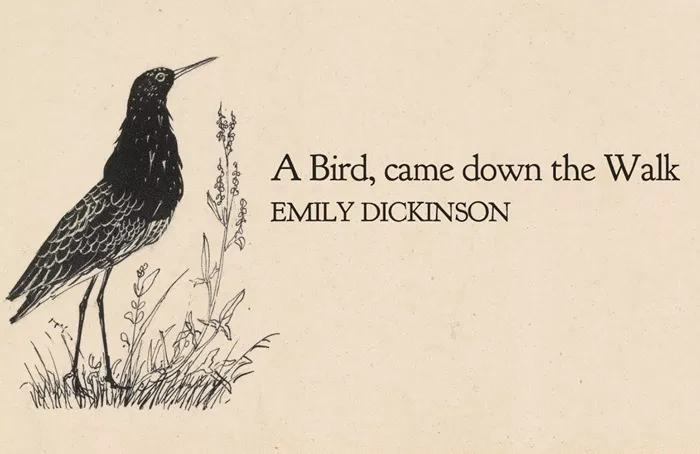Welcome to Poem of the Day – A Bird Came Down by Emily Dickinson.
Emily Dickinson, one of America’s most beloved poets, is known for her unique voice and her ability to capture moments in nature with profound depth. One of her most celebrated works, “A Bird Came Down,” explores the natural world through the delicate interactions between humans and wildlife. In this poem, Dickinson presents a bird in a moment of vulnerability, offering a glimpse into its life and its connection with the human observer. Let’s delve deeper into this poem and explore its meaning and significance.
A Bird Came Down Explanation
“A Bird Came Down” is a brief yet powerful poem that consists of five stanzas. Each stanza describes the bird’s actions and the interaction between the bird and the speaker. The bird initially appears as a free, untamed creature, yet the poem’s underlying theme reflects how humans and nature coexist in moments of quiet observation.
Stanza 1: The Bird’s Arrival
The first stanza begins with the image of a bird coming down from the sky. Dickinson describes the bird’s movement as graceful and fluid. The bird is depicted as a wild creature, moving quickly and confidently. However, this moment of beauty is interrupted when the bird becomes aware of the human observer.
“A Bird Came Down the Walk—
He did not know I saw—
He bit an Angleworm in halves
And ate the fellow, raw—”
Here, the speaker watches from a distance, unnoticed by the bird. The bird’s action—biting an angleworm in halves and eating it raw—introduces a darker, more primal aspect of nature. This contrasts with the earlier description of the bird as a beautiful, delicate creature. Dickinson uses this moment to highlight the bird’s wildness and the reality of survival in nature.
Stanza 2: The Bird’s Reactions
As the speaker observes, the bird becomes aware of their presence. The bird reacts by quickly looking around, clearly uncomfortable with the human gaze.
“The Bird flew down—
And then he paused—
He looked around—
And then he flew again—”
This stanza shows the bird’s wariness. The act of the bird pausing before flying away suggests that the bird is aware of its surroundings, especially the potential threat of humans. Despite this moment of vulnerability, the bird chooses to leave, maintaining its natural instinct to protect itself.
Stanza 3: The Bird’s Social Interaction
The third stanza introduces an element of human interaction. The speaker, seeing the bird’s wariness, decides to offer the bird a treat. Dickinson describes this offering as an act of kindness.
“Then, oars divide the Ocean,
Too silver for a seam—
Or Butterflies, off Banks of Noon
Leap, splashless, as they swim—”
In this metaphor, Dickinson compares the bird’s actions to the delicate movements of oars in the ocean or butterflies in flight. The imagery highlights the grace and beauty of both the bird and the natural world.
Stanza 4: The Symbolism of the Bird
The bird in this poem represents both freedom and vulnerability. Dickinson uses the bird’s flight as a symbol of independence and natural instinct. Yet, the bird’s awareness of the observer introduces a sense of caution, reminding the reader that freedom and vulnerability are often intertwined.
“He glanced with rapid eyes,
That hurried all around—
They glanced in the direction of—
A human presence found—”
This stanza emphasizes the tension between the bird’s natural freedom and the sudden intrusion of human presence. The bird is aware of the human observer, which contrasts with its earlier carefree behavior.
Stanza 5: The Conclusion
The final stanza offers a peaceful conclusion to the poem, as the bird flies away, returning to its natural habitat. The bird’s departure signifies its return to freedom and safety, leaving the human observer with a sense of wonder and respect for the natural world.
“Then, oars divide the Ocean,
Too silver for a seam—
Or Butterflies, off Banks of Noon
Leap, splashless, as they swim—”
The repeated imagery of nature’s delicate beauty underscores the poem’s theme of harmony between humans and the natural world.
Conclusion
In “A Bird Came Down,” Emily Dickinson captures a simple, yet profound moment in nature. The poem explores themes of freedom, vulnerability, and the delicate balance between humans and wildlife. Through her vivid imagery and careful observation, Dickinson invites readers to appreciate the beauty of the natural world while acknowledging its raw, untamed aspects. The poem serves as a reminder that nature is both a source of awe and a realm of survival, where even the most graceful creatures must navigate the complexities of existence.

